
Publisher:
Bonnie King
CONTACT:
Newsroom@Salem-news.com
Advertising:
Adsales@Salem-news.com

~Truth~
~Justice~
~Peace~
TJP
Sep-02-2006 23:27

 TweetFollow @OregonNews
TweetFollow @OregonNews
Historic SP&S 700 Steam Engine Comes to Salem (VIDEO)
Salem-News.comThousands brave the heat to take a look at massive steam engine.
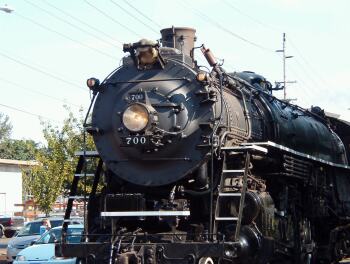 All photos by: Kevin Hays, Video by Kevin Montgomery |
(SALEM) - Thousands, from the young to the old, gathered Saturday morning at Salem’s Riverfront Park, to await the arrival of the SP&S 700 Steam Engine that was coming to town as part of the second annual SP&S 700 Rail Safety Faire.
 Many waited at the park, while others gathered along Front Street to take pictures, and look at the mighty locomotive, over 110 feet long and almost 17 feet tall, as it made it’s way slowly to Riverfront Park.
Many waited at the park, while others gathered along Front Street to take pictures, and look at the mighty locomotive, over 110 feet long and almost 17 feet tall, as it made it’s way slowly to Riverfront Park.
Originally, the train was to pull the "Plum Car" passenger car and a baggage car, along with a privately owned caboose.
That consist has been changed and will now include the 700 engine, the "Running Crane Lake" and "Casper Mountain", both former GN passenger cars and the caboose.
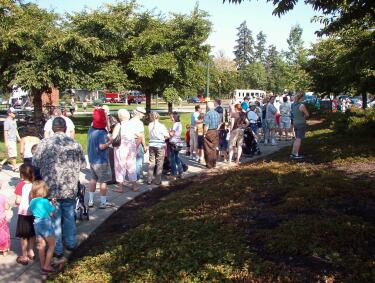 In January, the engine was officially listed on the National Register of Historic Places. The SP&S 700 received this honor because it is a working example of the peak of proven steam and rail technology as it was at the end of the Age of Steam.
In January, the engine was officially listed on the National Register of Historic Places. The SP&S 700 received this honor because it is a working example of the peak of proven steam and rail technology as it was at the end of the Age of Steam.
Train buffs, and others, waited, some for over an hour, in the hot sun, just to get an up close look inside the engines cab and former GN caboose.
SP&S history:
The history of the SP&S is vast and complex, involving steam railroads and paddlewheelers, portage lines and electric interurbans, transcontinental ambitions and broken dreams. No history short of book size can hope to tell the story. Be that as it may, the below is a short history of the line, a brief glimpse at the company that was "The Northwest's Own Railway".
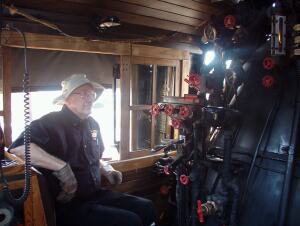 At the dawn of the twentieth century, the rail map of the Pacific Northwest was split by the Columbia River. Southwards, Oregon was firmly in control of Edward Harriman's twin railroads, the Union Pacific and the Southern Pacific. Portland, at the time the largest city in the Pacific Northwest, was served indirectly by the NP via Puget Sound, and the GN had no access to the city at all.
At the dawn of the twentieth century, the rail map of the Pacific Northwest was split by the Columbia River. Southwards, Oregon was firmly in control of Edward Harriman's twin railroads, the Union Pacific and the Southern Pacific. Portland, at the time the largest city in the Pacific Northwest, was served indirectly by the NP via Puget Sound, and the GN had no access to the city at all.
Meanwhile, hovering behind the Bitterroot Mountains, the Milwaukee Road was building across Montana, and seeking an outlet to the Pacific. One last obvious route lay unexploited by any railroad: the north bank of the Columbia River, a water level grade that would carry high tonnage with a minimum of effort. The Milwaukee coveted it; Harriman feared it; the NP saw it's promise as a better route to Portland, and moved to seize it for itself. Above the fray, James J. Hill, builder of the Great Northern and Harriman's arch rival, dreamed of California, and saw Oregon as a stepping stone along that route. In 1905, at Portland's Lewis & Clark Centenial Exhibition, Hill announced his intentions to build a railroad on that north bank, revealing that a company owned jointly by the GN and NP called the Portland & Seattle -- later renamed the Spokane, Portland & Seattle, to placate the residents of Spokane -- had been incorporated for that purpose.
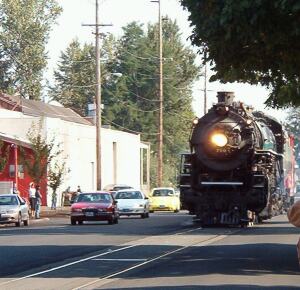 Construction soon followed. Instructed to build to the highest standards of the day, the SP&S -- running from Portland to Pasco via the northern bank of the Columbia, and thence along the edge of the Coulees and the Palouse to Spokane -- went way over budget. The line's "golden spike" was driven on March 11th, 1908, at MP 50.5, near North Bonneville.
Construction soon followed. Instructed to build to the highest standards of the day, the SP&S -- running from Portland to Pasco via the northern bank of the Columbia, and thence along the edge of the Coulees and the Palouse to Spokane -- went way over budget. The line's "golden spike" was driven on March 11th, 1908, at MP 50.5, near North Bonneville.
Though Hill at times regretted his decision to build the line, he pressed ahead regardless to thrust branches into the heart of Harriman's Oregon. Branches like the Oregon Electric, from Portland to Eugene, and the Oregon Trunk, from the SP&S main at Wishram to Central Oregon's Bend, plunged deep into Harriman territory and threatened to move onwards to California -- a dream the GN completed, in conjunction with the Western Pacific, long after Hill had died.
Traffic throughout the lifetime of the road was mostly grain west, lumber east. NP interchanged most of their Portland freight at Pasco, with secondary interchange occuring at Scribner, just west of Spokane. The GN, beginning in the 1930s, had trackage rights from Portland to Spokane and Bend, but ended up having shared / equalized operations with the SP&S.
As a result, GN power was often found on the line. The road's primary classification yard was at Wishram, and it's eastern terminus at Spokane alternated between NP's Yardley and GN's Hillyard facilities.
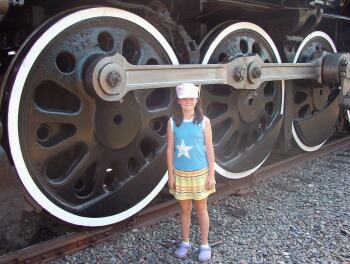 The SP&S primarily operated with second hand equipment handed down from the parent roads. As her parent companies were not always on good terms with each other, the SP&S was watched like a hawk, each owner careful to be sure that moneys put in by one did not end up in the pocket of the other. One of the results of this was that, although the SP&S had their own freight cars, the road was still largely dependent on parents to meet freight car demands.
The SP&S primarily operated with second hand equipment handed down from the parent roads. As her parent companies were not always on good terms with each other, the SP&S was watched like a hawk, each owner careful to be sure that moneys put in by one did not end up in the pocket of the other. One of the results of this was that, although the SP&S had their own freight cars, the road was still largely dependent on parents to meet freight car demands.
It was not until the arrival of the Z6 class mallets in 1937, followed by the E1 class northerns in 1938, (both tacked onto NP orders,) that the SP&S enjoyed a significant influx of new power. But what new power it was! When the mallets arrived in Vancouver, the firebox was large enough that a banquet was given inside of it.
World War Two provided the traffic boost that the SP&S needed. The combination of war materials movements and cheap electric power from the Columbia Dams of the Bonneville Power Administration resulted in the location of major aluminum plants, sawmills, chemical facilities and grain terminals along the line.
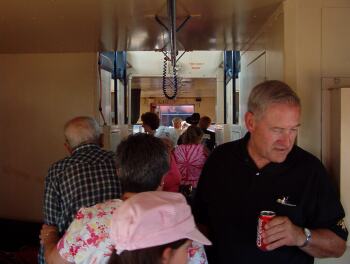 During the war, dieselization began to take place on a slow schedule. Beginning with the arrival of switchers from Alco and Baldwin, the SP&S invested primarily in Alcos throughout it's diesel years. To many, the SP&S is synonymous with Alco RS3's, FA's, and Century 424's, 425's, and 636's.
During the war, dieselization began to take place on a slow schedule. Beginning with the arrival of switchers from Alco and Baldwin, the SP&S invested primarily in Alcos throughout it's diesel years. To many, the SP&S is synonymous with Alco RS3's, FA's, and Century 424's, 425's, and 636's.
By the mid 1960s, it was clear the the parent road intended to merge together, and in 1970, the effort became a reality in the form of Burlington Northern. Although the SP&S continued to exist as a paper corporation until 1979, the separate identity of the road that was know as "The Northwest's Own Railway" ended at BN's birth. Ironically, the final engines ordered by the SP&S, six GP38s from GM-EMD, were delivered in BN Cascade green and black, and were amongst the first units to wear the new company's scheme.
Post merger, changes came to the SP&S. BN stationed almost all of it's Alco diesel fleet out of the Vancouver roundhouse, as a maintenance related economy measure; this was followed by early retirement of many of these Schenectady products in 1980, as the influx of GM-EMD SD40-2's arrived.
Expensive though it was to build, the SP&S's water level route was amongst the best engineered lines that BN inherited, and even today, it is the primary PNW mainline of BN's successor, Burlington Northern Santa Fe. The third subdivision, running from Pasco to Spokane and often referred to as the "High Line", was first paired with the NP main, effectively creating double track between those two points. This did not last, however, and in the early 1990s, while BN was on an abandonment kick, this line was abandoned and removed. The third sub now exists only as a horse trail.
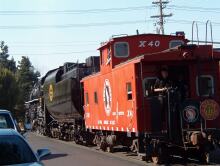 The OT, once a major thoroughfare for WP traffic to the PNW, closed when that company became part of Union Pacific, but reopened again when BNSF gained trackage rights over the old WP as a concession in the UP+SP merger. And the branches of Western Oregon -- the A-Line to Astoria and the Oregon Electric to Eugene -- live on as part of Portland & Western, a regional railroad affiliated with the Genesee & Wyoming shortline conglomerate.
The OT, once a major thoroughfare for WP traffic to the PNW, closed when that company became part of Union Pacific, but reopened again when BNSF gained trackage rights over the old WP as a concession in the UP+SP merger. And the branches of Western Oregon -- the A-Line to Astoria and the Oregon Electric to Eugene -- live on as part of Portland & Western, a regional railroad affiliated with the Genesee & Wyoming shortline conglomerate.
Last but not least, one of the railway's E1 northerns, SP&S 700, long on display in Portland's Oaks Park, was restored in the late 1980s and early 1990s, and is once again in fully operable condition. Fondly referred to as "The Lady", she completed a successful tour of Montana Rail Link in 2002.
(Information from www.spshs.org)
WATCH THE VIDEO NEWS REPORT BELOW BY SALEM'NEWS.COM'S TIM KING AND KEVIN MONTGOMERY
Articles for September 1, 2006 | Articles for September 2, 2006 | Articles for September 3, 2006
Quick Links
DINING
Willamette UniversityGoudy Commons Cafe
Dine on the Queen
Willamette Queen Sternwheeler
MUST SEE SALEM
Oregon Capitol ToursCapitol History Gateway
Willamette River Ride
Willamette Queen Sternwheeler
Historic Home Tours:
Deepwood Museum
The Bush House
Gaiety Hollow Garden
AUCTIONS - APPRAISALS
Auction Masters & AppraisalsCONSTRUCTION SERVICES
Roofing and ContractingSheridan, Ore.
ONLINE SHOPPING
Special Occasion DressesAdvertise with Salem-News
Contact:AdSales@Salem-News.com


googlec507860f6901db00.html


Terms of Service | Privacy Policy
All comments and messages are approved by people and self promotional links or unacceptable comments are denied.
[Return to Top]
©2025 Salem-News.com. All opinions expressed in this article are those of the author and do not necessarily reflect those of Salem-News.com.